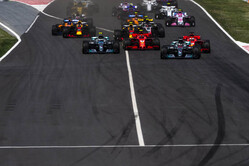


22/08/2018
NEWS STORY
 With the final proposals for the engine rules and redistribution of the prize money post-2020 yet to be presented to the teams and manufacturers, far less agreed, according to the sport's technical boss, Ross Brawn, the sport simply cannot afford another two years of what is effectively three teams battling for supremacy and the remaining seven fighting for best of the rest.
With the final proposals for the engine rules and redistribution of the prize money post-2020 yet to be presented to the teams and manufacturers, far less agreed, according to the sport's technical boss, Ross Brawn, the sport simply cannot afford another two years of what is effectively three teams battling for supremacy and the remaining seven fighting for best of the rest.
Indeed, with an eye on the recent issues surrounding Force India, and the admission from both McLaren and Williams that they too are struggling, there are fears that unless action is taken soon more teams could fall by the wayside.
As a result, having already admitted that it is seeking to introduce a budget cap in 2021, the sport is now looking to begin the process as early as next year.
"On the economic side we're pushing through cost control initiatives," said Brawn ahead of this weekend's Belgian Grand Prix. "Working with the FIA and in consultation with the teams we are progressing well on the economic initiatives. Work on the mechanism of a cost cap is going well.
"At the moment we are looking to introduce it in a soft form, with dry runs in 2019, and 2020," he revealed, "then it will be become regulatory in 2021.
"I would say that barring some last-minute discussions that's pretty much finalised now."
While a figure has yet to be confirmed (or agreed), it is widely understood that the sport is looking at a cap of around $150m.
"To be clear, we want the grandees to still be the big names in the sport," said Brawn, aware that Mercedes and Ferrari are far from happy with the proposals, "we don't want a system or a situation where there aren't big targets to aim at. And at the moment, those targets are Ferrari, Mercedes and Red Bull.
"However, the void between those three teams and the rest of the field is too big," he continued. "There are two divisions in Formula 1, and we want to stop that, we want to introduce constraints on the amount of resource you can use. And doing that involves both an economic perspective and a technical perspective.
"At the moment a top team spends twice what a midfield team spends and if we reduce that margin to around ten or twenty per cent, then there is something for the midfield teams to aspire to. There will still be an aura around the big teams, but a midfield team doing a great job will be able to compete.
"We only have to look at the situation Force India finds itself in to understand how crucial this is," he said. "The financial burden on teams is not sustainable in the long term and we are taking steps to put a limit on how much a team can spend. We hope the cost controls will make smaller teams more sustainable, as they'll be in a better position to show sponsors and investors that they have a chance of getting on the podium, and in the right circumstance, of winning a race.
"That's so important for a team that's aspiring to become a grandee. At the moment, the void is too big; it's almost impossible for a team to bridge that gap."